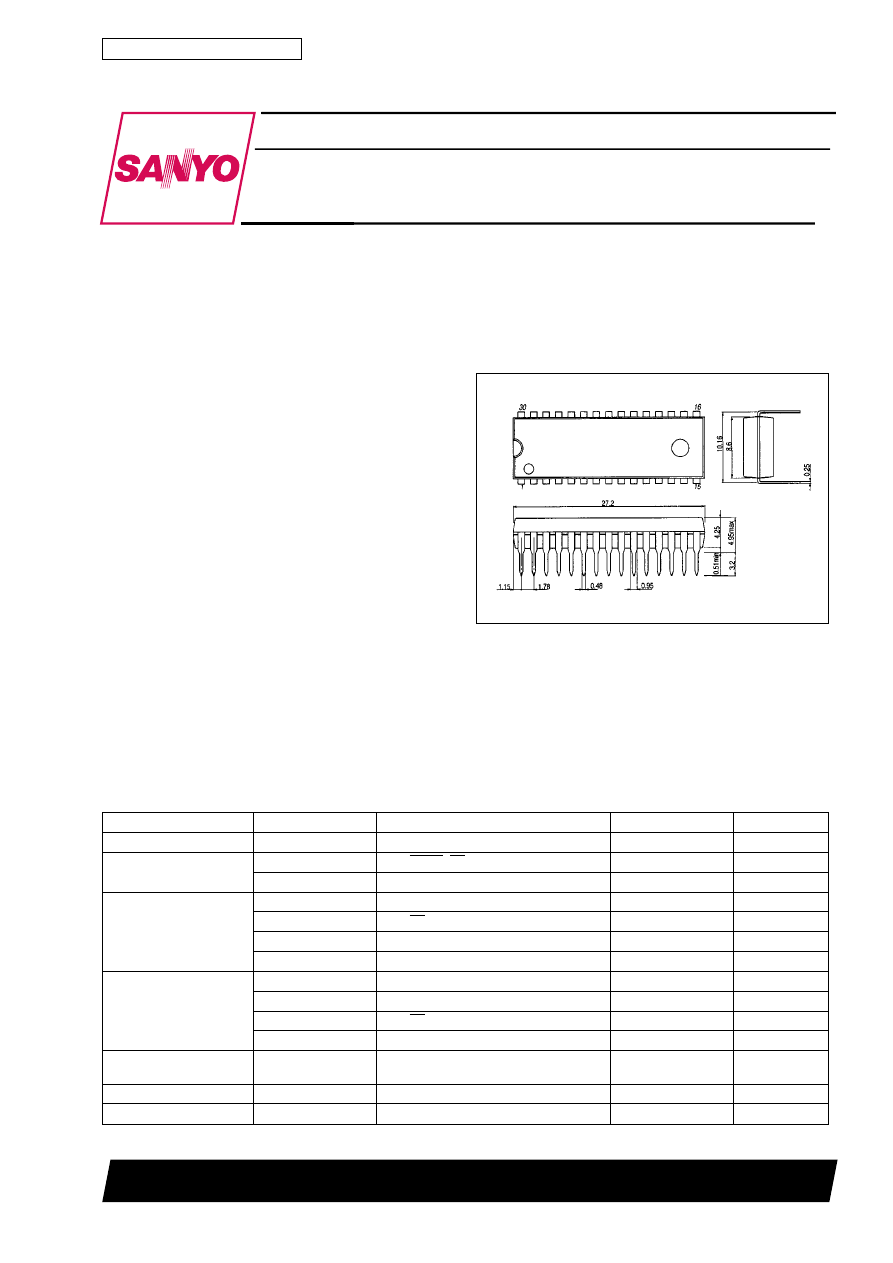
CB Transceiver PLL Frequency Synthesizer
and Controller
Overview
This 27 MHz band, PLL frequency synthesizer LSI chip is
designed specifically for CB transceivers.
The specifications are suited for use in U.S.A.(FCC).
Functions
The LC7185-8750 incorporates PLL circuitry and a controller
for CB applications on a single CMOS chip. The controller
handles the PLL circuitry, frequency data ROM, channel
preset/recall RAM, and LED display driver. It also supports
channel scan, channel preset/recall, and emergency channel
call.
Features
1. A built-in programmable divider for the 16 MHz VCO
2. Transmission is inhibited when the PLL is unlocked (digital
lock monitor).
3. Direct channel 9 or 19 selection (sliding switch)
4. A 7-segment, 2-character LED display
5. ‘‘PA’’ is displayed in public announcement mode.
6. Output beep-tone control circuitry
7. Up to 5 channel settings can be stored in memory.
8. 4
×
3 key matrix implementation
Package Dimensions
unit : mm
3061-DIP30S
[LC7185-8750]
SANYO : DIP30S (400 mil)
Specifications
Absolute Maximum Ratings
at Ta = 25°C, V
SS
= 0 V
Parameter
Symbol
Conditions
Ratings
Unit
Maximum supply voltage
V
DD
max
Pin V
DD
–0.3 to +9.0
V
Input voltage
V
IN
1 max
Pins HOLD, TX
–0.3 to +15
V
V
IN
2 max
Input pins other than V
IN
1 max
–0.3 to V
DD
+0.3
V
Output voltage
V
O
1 max
Pins SA, SB, SC, SD, SE, SF, SG, D1, D2
–0.3 to +15
V
V
O
2 max
Pins UL, BEEP
–0.3 to +15
V
V
O
3 max
Pin PD
–0.3 to V
DD
+0.3
V
V
O
4 max
Output pins other than mentioned above
–0.3 to V
DD
+0.3
V
Output Current
I
O
1 max
Pins SA, SB, SC, SD, SE, SF, SG
0 to +30
mA
I
O
2 max
Pins D1, D2
0 to +10
mA
I
O
3 max
Pins UL
0 to +20
mA
I
O
4 max
Pin BEEP
0 to +10
mA
Allowable power
dissipation
Pd max
(Ta
%
85°C)
350
mW
Operating temperature
Topr
–40 to +85
°C
Storage temperature
Tstg
–55 to +125
°C
Ordering number: EN 3356A
CMOS IC
LC7185-8750
SANYO Electric Co.,Ltd. Semiconductor Bussiness Headquarters
TOKYO OFFICE Tokyo Bldg., 1-10, 1 Chome, Ueno, Taito-ku, TOKYO, 110-8534 JAPAN
73098HA(II)/5220TA No.3356-1/12

Allowable Operating Conditions
at Ta = –40 to +85°C, V
SS
= 0 V
Parameter
Symbol
Conditions
min
typ
max
Unit
Supply voltage
V
DD
5.0
8.0
V
Input high-level voltage
V
IH
1
Pins HOLD, TX
0.7V
DD
12
V
V
IH
2
Pin INIT
3.2
V
DD
V
V
IH
3
Pins KI1, KI2, KI3, KI4
0.6V
DD
V
DD
V
Input low-level voltage
V
IL
1
Pins HOLD, TX
0
0.3V
DD
V
V
IL
2
Pin INIT
0
1.3
V
V
IL
3
Pins KI1, KI2, KI3, KI4
0
0.4V
DD
V
Output voltage
V
OUT
1
Pins SA, SB, SC, SD, SE, SF, SG, D1, D2
0
13
V
V
OUT
2
Pins UL, BEEP
0
8
V
Input frequency
f
IN
1
Pin XIN (sine wave, capacitor coupled)
1.0
10.24
15
MHz
f
IN
2
Pin PIN (sine wave, capacitor coupled)
10
30
MHz
Input amplitude
V
IN
1
Pin XIN (sine wave, capacitor coupled)
0.5
1.5
Vrms
V
IN
2
Pin PIN (sine wave, capacitor coupled)
0.15
1.5
Vrms
Required oscillating
frequency
X’tal
Pins XIN, XOUT (CI
%
50
Ω
)
5.0
10.24
15
MHz
Electrical Characteristics
at under allowable operating conditions
Parameter
Symbol
Conditions
min
typ
max
Unit
Internal feedback resistance
Rf1
Pin XIN
1.0
M
Ω
Rf2
Pin PIN
500
k
Ω
Pull-down resistor
RpdN
Pins KI1, KI2, KI3, KI4, TEST
30
50
70
k
Ω
Input high-level current
I
IH
1
Pins HOLD, TX V
I
= 12 V
5.0
µA
I
IH
2
Pin INIT V
I
= V
DD
5.0
µA
I
IH
3
Pin XIN V
I
= V
DD
25
µA
I
IH
4
Pin PIN V
I
= V
DD
50
µA
Input low-level current
I
IL
1
Pins HOLD, TX V
I
= V
SS
5.0
µA
I
IL
2
Pin INIT V
I
= V
SS
5.0
µA
I
IL
3
Pin XIN V
I
= V
SS
25
µA
I
IL
4
Pin PIN V
I
= V
SS
50
µA
Output high-level voltage
V
OH
1
Pins KO1, KO2, KO3 I
O
= 1 mA
V
DD
–2.0
V
DD
–1.0
V
DD
–0.5
V
V
OH
2
Pin PD I
O
= 0.5 mA
V
DD
–1.0
V
Output low-level voltage
V
OL
1
Pins KO1, KO2, KO3 I
O
= 20 µA
0.6
1.0
1.4
V
V
OL
2
Pin PD I
O
= 0.5 mA
1.0
V
V
OL
3
Pin BEEP I
O
= 2 mA
1.0
V
V
OL
4
Pins SA, SB, SC, SD, SE, SF, SG
I
O
= 20 mA
1.0
V
V
OL
5
Pins D1, D2 I
O
= 5 mA
1.0
V
V
OL
6
Pin UL I
O
= 10 mA
1.0
V
Output leakage current
I
OFF
1
Pins SA, SB, SC, SD, SE, SF, SG, D1, D2
V
O
= 13 V
5.0
µA
I
OFF
2
Pins UL, BEEP V
O
= 8 V
5.0
µA
High-level tristate leakage
current
I
OFFH
Pin PD V
O
= V
DD
0.01
10.0
nA
Low-level tristate leakage
current
I
OFFL
Pin PD V
O
= V
SS
0.01
10.0
nA
Supply current
I
DD
1
Normal mode
*
1 (PLL operates)
5
10
mA
I
DD
2
Hold mode V
DD
= 3.2 V
*
2 (memory backup)
V
DD
= 8.0 V
5
15
µA
µA
*1: f
IN
2 = 20 MHz (PIN)
V
IN
2 = 0.15 Vrms
X’tal = 10.240 MHz
TX = HOLD = INIT = V
DD
Other inputs = V
SS
Other outputs = open
*2: HOLD = V
SS
TX = INIT = V
DD
Other inputs = V
SS
Other outputs = open
Note: Be careful that the dielectric strength of pins SA, SB, SC, SD, SE, SF, D1, D2, UL, BEEP are weak.
LC7185-8750
No. 3356-2/12
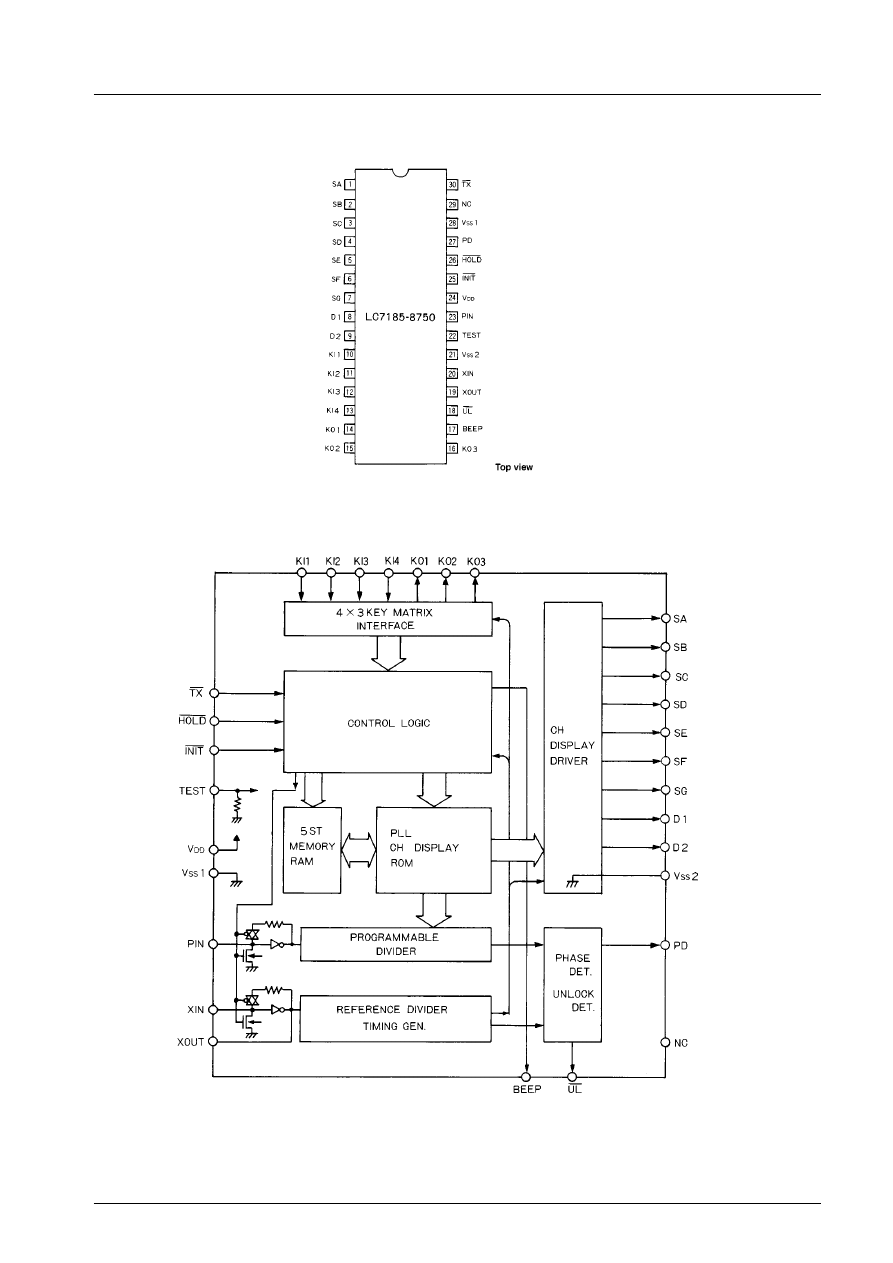
Pin Assignment
Block Diagram
LC7185-8750
No. 3356-3/12
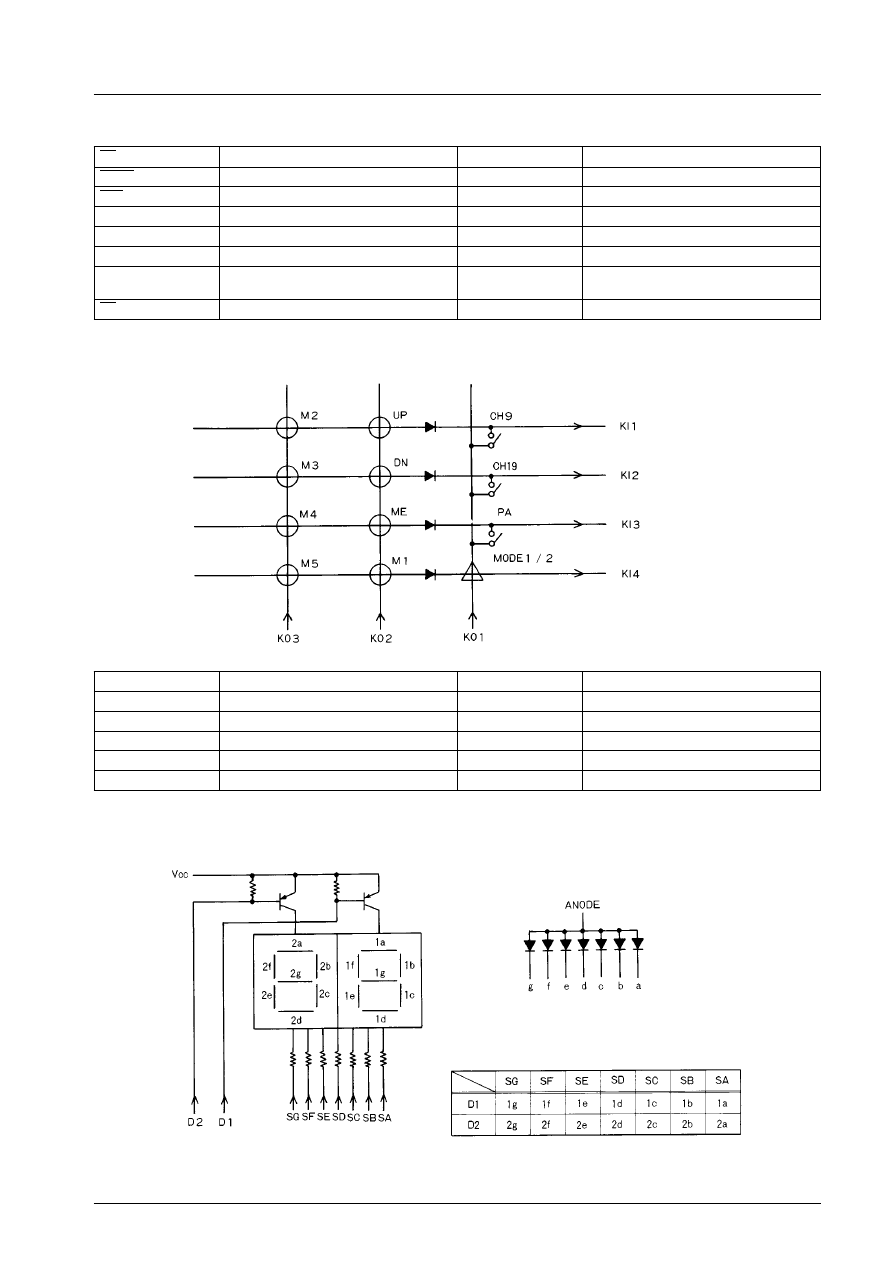
Pin Descriptions
TX
Transmit/receive select
PD
Charge pump output
HOLD
Hold mode select
NC
NC pin
INIT
Initial input
SA to SG
Segment driver (for display)
TEST
Test point (input)
D1, D2
Digit output (for display)
V
DD
, V
SS
1, V
SS
2
Power supply
KI1 to KI4
Key inputs
PIN
Programmable divider input
KO1 to KO3
Key scan outputs
XIN, XOUT
Crystal oscillator input, output
(10.240 MHz)
BEEP
Beep-tone control output
UL
Unlock detection signal output
Key Matrix
CH9
Emergency CH9 recall
ME
Station Memory Enable
CH19
Emergency CH19 recall
M1 to M5
Station Memory recall
PA
Public announcement display
UP/DN/ME/M1 to 5
Momentary SW
MODE 1/2
Display Mode
CH9/CH19/PA
Slide SW
UP
CH up/scan
MODE 1/2
Diode
DN
CH down/scan
LED Display Configuration (Common anode/7 segment)
LC7185-8750
No. 3356-4/12
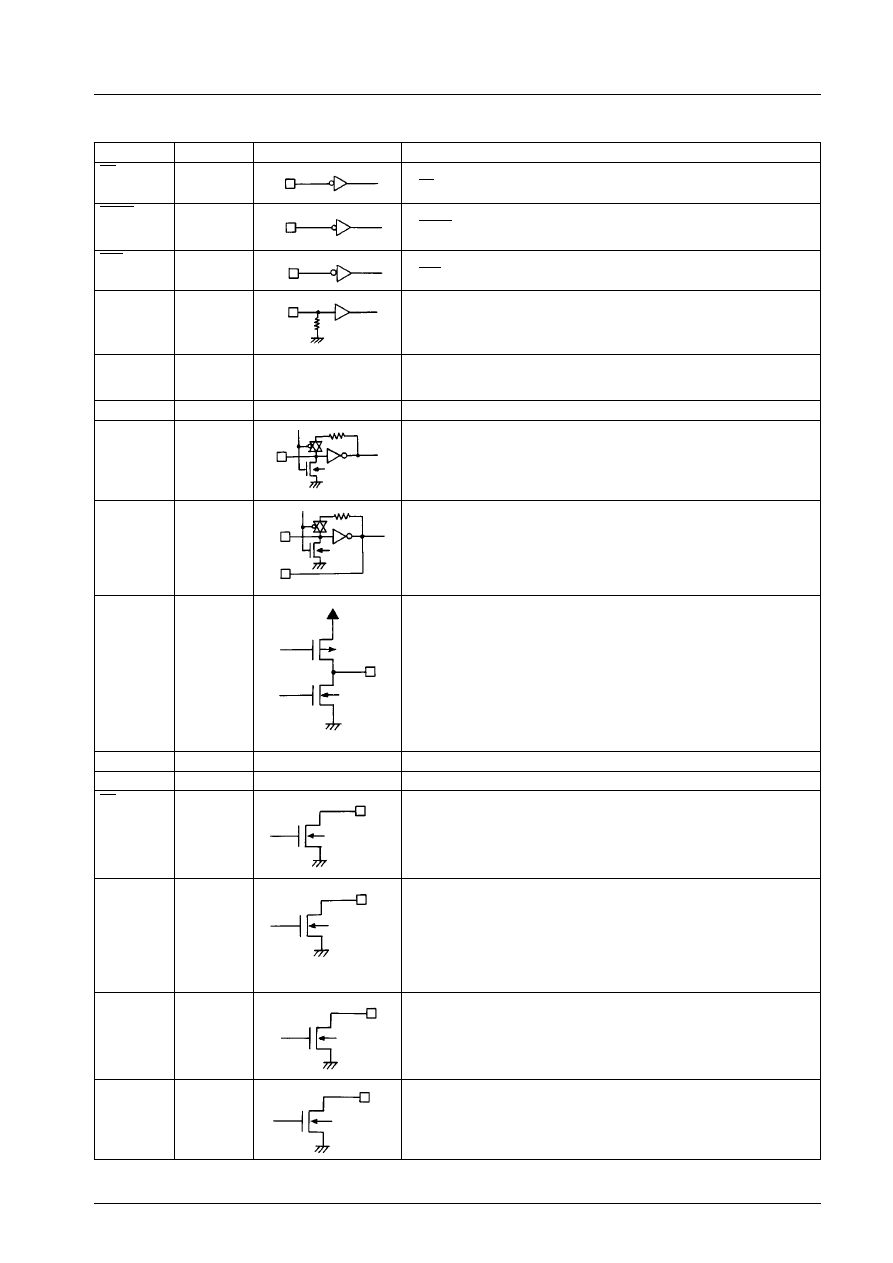
Pin Description
Pin Name
Pin No.
Type
Description
TX
30
.
Transmit/receive select
TX = ‘‘0’’...Transmit, TX = ‘‘1’’...Receive
HOLD
26
.
Hold mode select
HOLD = ‘‘0’’...Hold mode select
= ‘‘1’’...Normal mode select
INIT
25
.
Reset line
INIT = ‘‘0’’...Reset
TEST
22
.
Test point (input)
Tie to ground or leave floating
V
DD
24
.
Power supply (+)
Normal mode: 5.0 to 8.0 V
Hold mode:
^
3.2 V
V
SS
2
21
.
Channel display LED driver ground
PIN
23
.
Programmable divider input
150 mVrms min
Hold mode: Programmable divider is disabled.
XIN
XOUT
20
19
.
Crystal oscillator
Frequency: 10.24 MHz
Hold mode: Oscillator is disabled.
PD
27
.
Charge pump output from the phase comparator. If the frequency of fV
(the signal obtained by dividing the PIN input by N) is higher than that of
fR (the reference signal), or if the phase of fV leads that of fR, positive
pulses are output on this pin. If the frequency is lower or the phase lags,
negative pulses are output on this pin. If they match, the pin goes to high
impedance.
.
fV > fR OR leading: Positive Pulses
.
fV < fR OR leading: Negative Pulses
.
fV = fR and phase muched: High impedance
Hold mode: High impedance
V
SS
1
28
.
PLL circuit and controller ground
NC
29
.
No-connection
UL
18
.
Unlock detected output
Fixed to low level when unlocked, when changing channels, in PA mode,
or in hold mode.
Open: Locked
BEEP
17
.
Beep-tone control output
During station memory operation
During I/O on emergency channel
When changing channels
—
During reset
During hold mode recovery
Fixed to low level in hold mode
Transistor: Off (50 ms cycle)
→
Open
SA to SG
1 to 7
.
Segment drivers for the display
(Common anode/7 segments)
D1
D2
8
9
.
Digit output (150 Hz) for the display
(common anode/7 segments)
Hold mode: Transistor goes off.
Continued on next page.
LC7185-8750
No. 3356-5/12
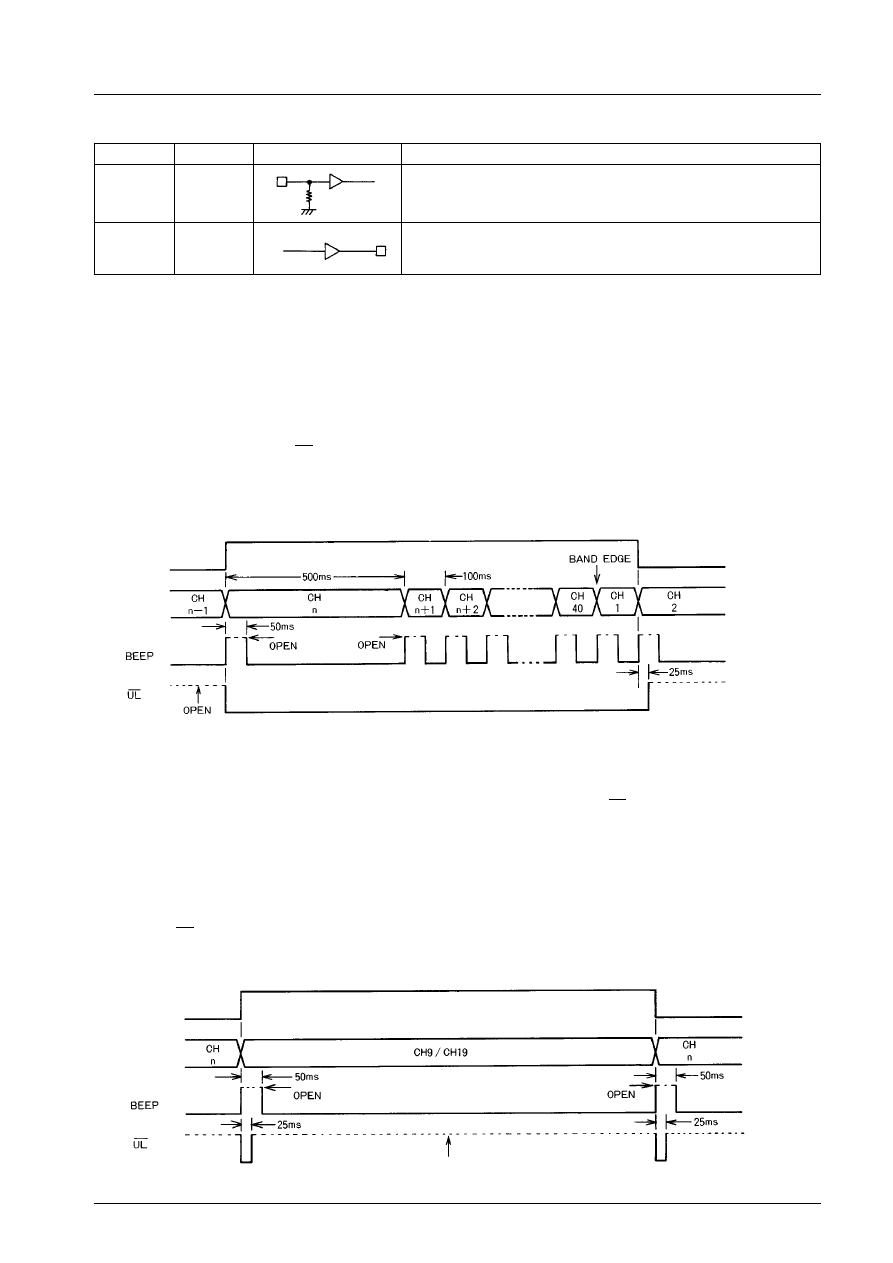
Continued from preceding page.
Pin Name
Pin No.
Type
Description
KI1 to KI4
10 to 13
.
Key inputs
Input from the key matrix
KO1 to KO3
14 to 16
.
Key scan output (75 Hz)
Output to the key matrix
Hold mode: Low (scanning stops)
Operation
(1) Channel Selection (up/down)
1.
Manual scanning (up/down)
Pressing the UP key increments by one channel and pressing the DN key decrements by channel.
When scanning reaches the end of the band, it automatically wraps around to the beginning.
2.
Auto scanning (up/down)
Holding the UP (or DN) key down for 500 ms or longer starts auto scanning. For both up and down scanning, each
channel takes 100 ms to scan.
3.
The unlock detected line (UL) is asserted (low) when the UP (or DN) key is pressed and deactivated 25 ms after the key
is released.
4.
The beep-tone control line (BEEP) is asserted (open) for 50 ms after each new channel is selected.
(2) Selecting an Emergency Channel (CH9/CH19)
1.
If the CH9 or CH19 switch is turned on, the LC7185 stores the value of the previous channel and asserts the beep-tone
control line for 50 ms.
2.
While the CH9 or CH19 switch is turned on, the LC7185 disables all keys except TX and PA (UP/DN, ME, and M1 to
M5 switches).
3.
Even if the CH9 or CH19 switch is turned off while transmitting using the CH9 or CH19 switch, keep the emergency
channel open until the LC7185 is in the receive mode.
4.
After the CH9 or CH19 switch is turned back off, the beep-tone control line is asserted for 50 ms and the LC7185
reopens the previous channel.
5.
Note the CH9 has a higher priority over CH19. As a result, if both switches are turned on, CH9 will be opened.
6.
The UL line is asserted for 25 ms after the CH9 or CH19 switch is turned off or on.
7.
Causes either ‘‘9’’ or ‘‘19’’ to blink on the display.
UP/DN Key
Channel
CH9/CH19
Switch
Channel
Lock: Open
LC7185-8750
No. 3356-6/12
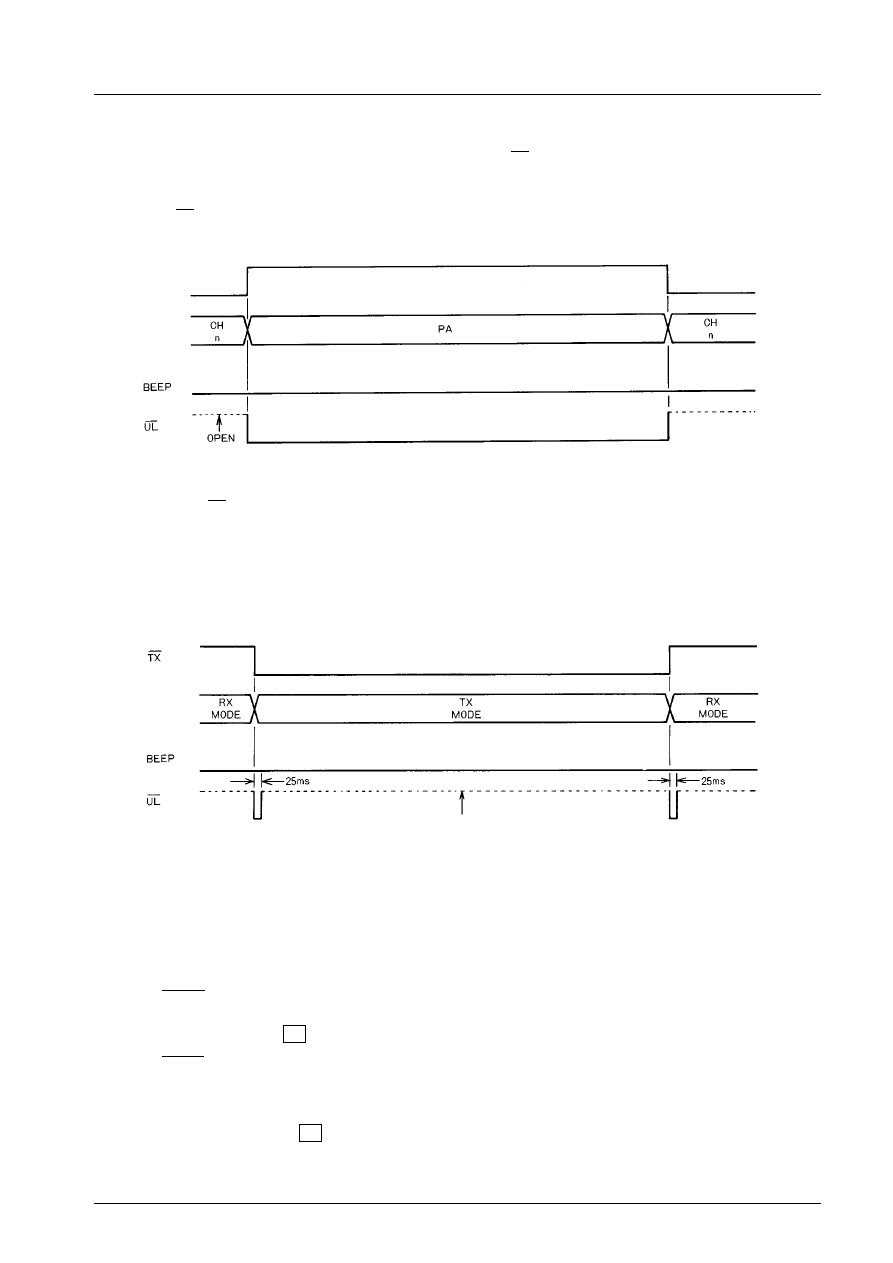
(3) Public Announcement (PA) Mode
1.
When the PA switch is turned on, the LC7185 stores the value of the previous channel and enters the PA mode.
2.
While the PA switch is turned on, the LC7185 disables all keys (TX, CH9/CH19, UP/DN, ME, M1 to M5)
3.
‘‘PA’’ is displayed on the channel display.
4.
When the PA switch is turned back off, the LC7185 enters the CB mode and reopens the previous channel.
5.
The UL line is asserted while the PA switch is turned on.
(4) Transmit/Receive Selection
1.
When the TX line is asserted, the LC7185 enters TX mode.
2.
If the PA switch is turned on while the LC7185 is in TX mode, the device enters PA mode. However, if any other
switch (other than the PA switch) or key (UP/DN, ME, M1 through M5, CH9, CH19) is pressed while the LC7185 is in
TX mode, that switch or key has no effect.
3.
The unlock detected signal is output each time the device switches between transmitting and receiving.
(5) Channel Preset/Recall Facility
1.
The LC7185 allows up to 5 channels to be preset (assigned to M1 to M5).
.
After a reset (when the power is turned on, etc.), M1 to M5 are assigned to CH33.
2.
Recalling preset channels
.
A preset channel is recalled by pressing one of the preset memory keys (M1 to M5) to which the channel was
previously assigned.
.
There are two different display modes as shown below.
Mode 1 (without diode)
Each time a key is pressed (M1 to M5), the new channel is displayed.
Example: Display 21
→
15
key
M1
Mode 2 (with diode)
Each time a key is pressed (M1 to M5), a key mnemonic (‘‘P1’’ to ‘‘P5’’) is displayed for 400 ms, then the new
channel is displayed.
Example: Display 21
→
P1
→
15
400 ms
Key
M1
PA switch
Channel
(Display)
Pin
Lock: Open
LC7185-8750
No. 3356-7/12
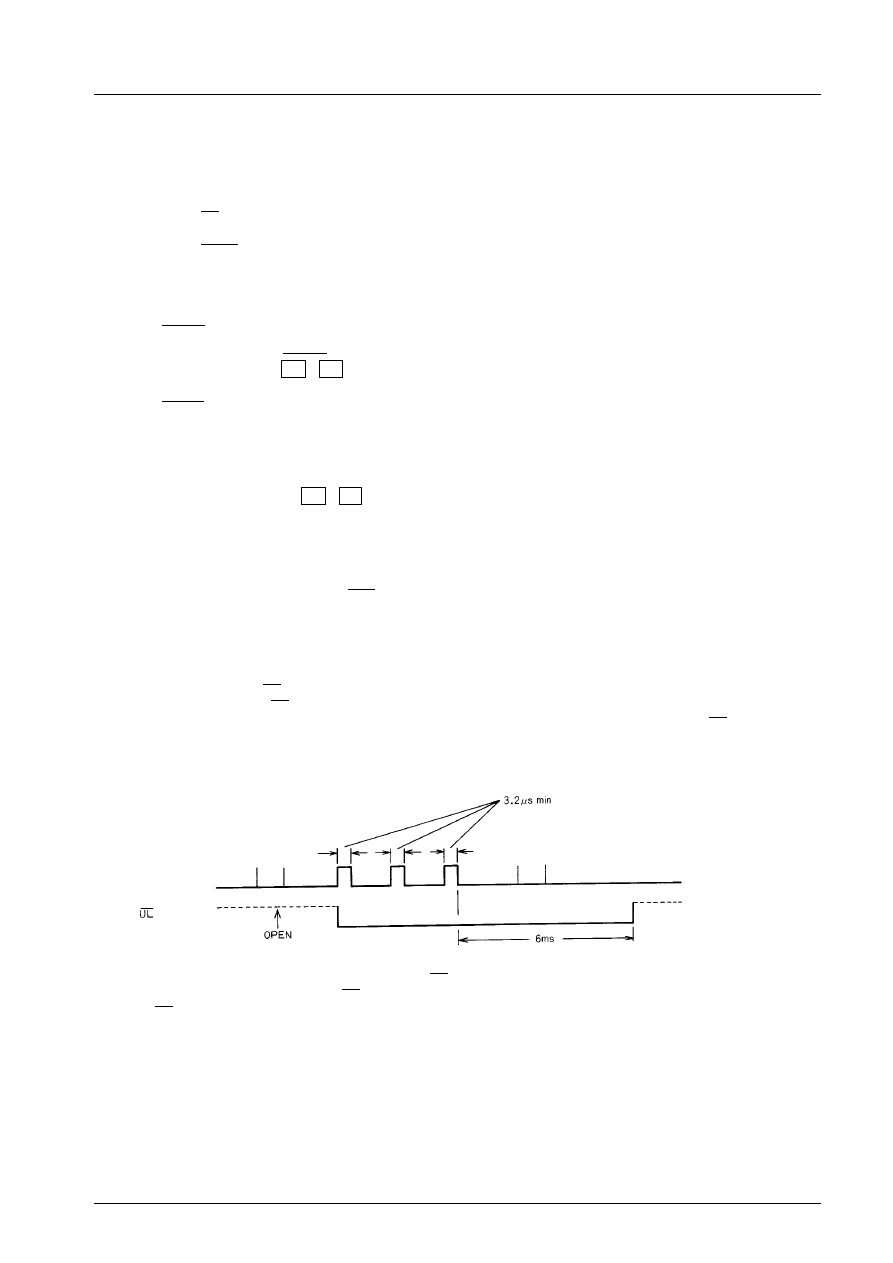
3.
Presetting channels
.
First select the channel to be preset, then hold down the ME key and press the preset memory key (M1 to M5) to
which you would like to assign the current channel.
In the following cases, a channel will not be preset:
.
M1 to M5 is pressed and in the memory preset mode.
.
Emergency channels CH9 or CH19 are currently selected.
.
The TX line is asserted.
.
The PA switch is turned on (PA mode).
.
The HOLD line is asserted (hold mode).
Even if the above key operations are not performed, the preset mode will be canceled automatically after 9 seconds.
.
There are two different display modes as shown below.
Mode 1 (without diode)
The current channel is displayed throughout the preset process.
Example: Display 15
→
15
Key
ME
M1
Mode 2 (with diode)
When the ME key is held down, ‘‘PE’’ is flashed on the display, indicating that presetting is possible. Once a
preset memory key (M1 to M5) is pressed, the key mnemonic (‘‘P1’’ to ‘‘P5’’) is displayed for 400 ms before the
current channel is redisplayed.
Example: Display 15
→
PE
→
P1
→
15
Key
ME
M1
400 ms
.
Note that if two or more keys are pressed at the same time, priority is assigned as follows:
M1 > M2 > M3 > M4 > M5
(6) Beep-tone Control Output (BEEP pin)
After each of the following events, the BEEP line is asserted for 50 ms:
.
A reset, such as a battery replacement (INIT = 0)
.
Any key press associated with the channel memory
.
Any emergency channel switch activation
.
A new channel is selected
.
Leaving hold mode
(7) Unlock Detected Output (UL pin)
In the following cases, the UL line is asserted.
.
When the phase difference between the programmable and reference divider outputs exceeds 3.2 µs, the UL line is held low
for 6 ms after the last out-of-range phase sample is detected, as shown below.
.
After a new transmit/receive or channel selection, the UL line is asserted for 25 ms.
.
While the PA switch is turned on, the UL line is asserted during PA mode.
.
The UL pin is open while the device is in the PLL LOCK state (when the phase difference is < 3.2 µs).
Phase
difference
pin
LC7185-8750
No. 3356-8/12
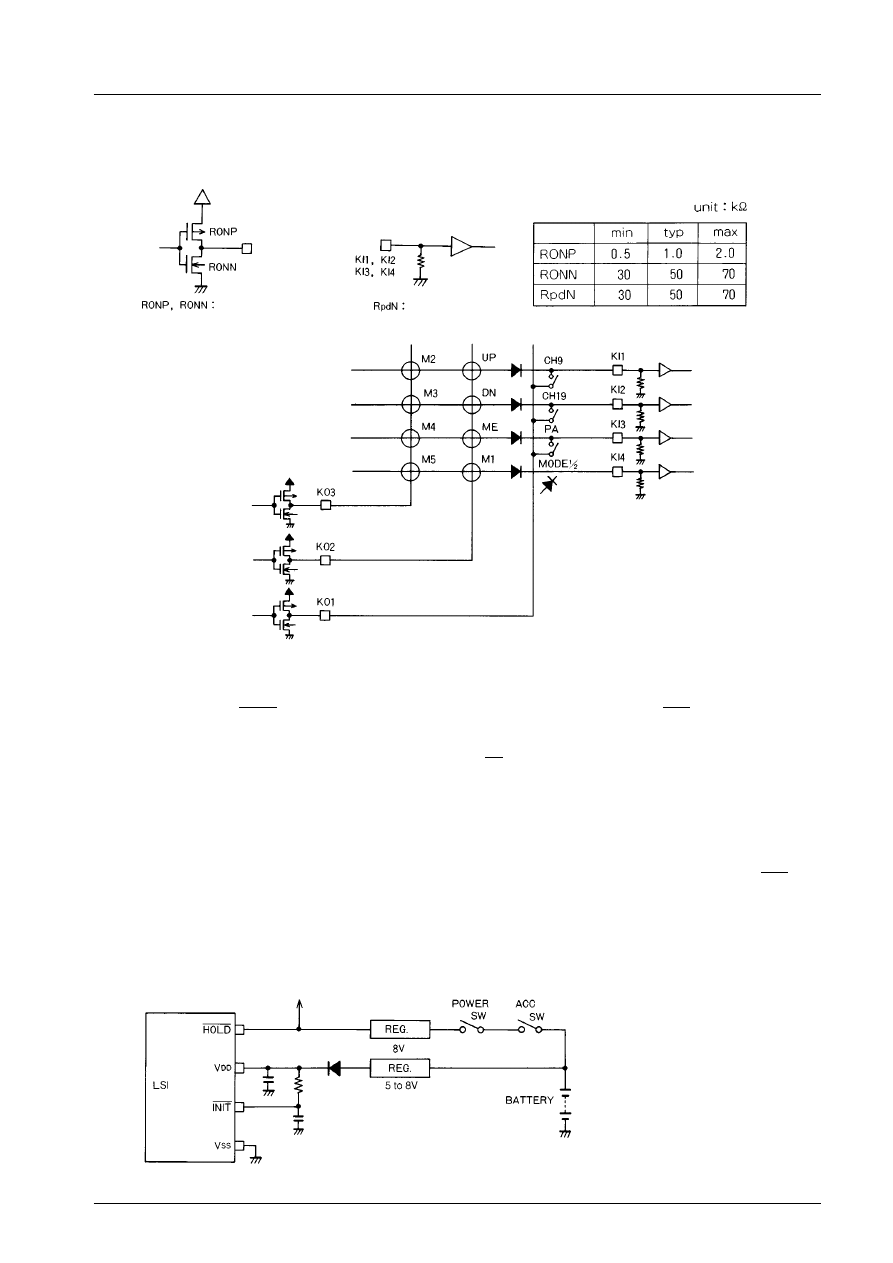
(8) Key Matrix
It is normal to put diodes in series with the key scanning lines to avoid creating a short with the output lines.
But KO1, KO2 and KO3 lines (key scan signal output) do not need diodes.
Explanation Regarding Power On and Hold Mode
(1) Operation in hold mode
When in hold mode (HOLD = 0), the LC7185-8750 does not accept any operation other than the INIT pin being asserted
(reset). The primary function of hold mode is to maintain the contents of station memory.
.
In hold mode, the programmable divider, crystal oscillator and reference divider are all stopped.
The PD pin (charge pump output) goes to high impedance. The UL pin goes to V
SS
.
.
The channel display pins D1 and D2 go to high impedance.
.
The BEEP pin goes to V
SS
.
.
The key scan signal outputs (KO1 to KO3) go to V
SS
.
When the LC7185-8750 leaves hold mode, the previously selected channel is reopened.
(2) Initial state settings
The LC7185-8750 can be reset to its initial state settings (reset) after the battery has been replaced, etc., by setting INIT = 0.
The initial state that is established by an initial reset is as follows:
.
When the V
DD
pin turned on, CH9 or CH33 is selected.
.
When the V
DD
pin operate voltage already, CH9 is selected.
.
All of station memory is set to CH33.
Pins KO1,
KO2, KO3
On impedance
pins
Pull-down resistor
Item
Linear circuit
LC7185-8750
No. 3356-9/12
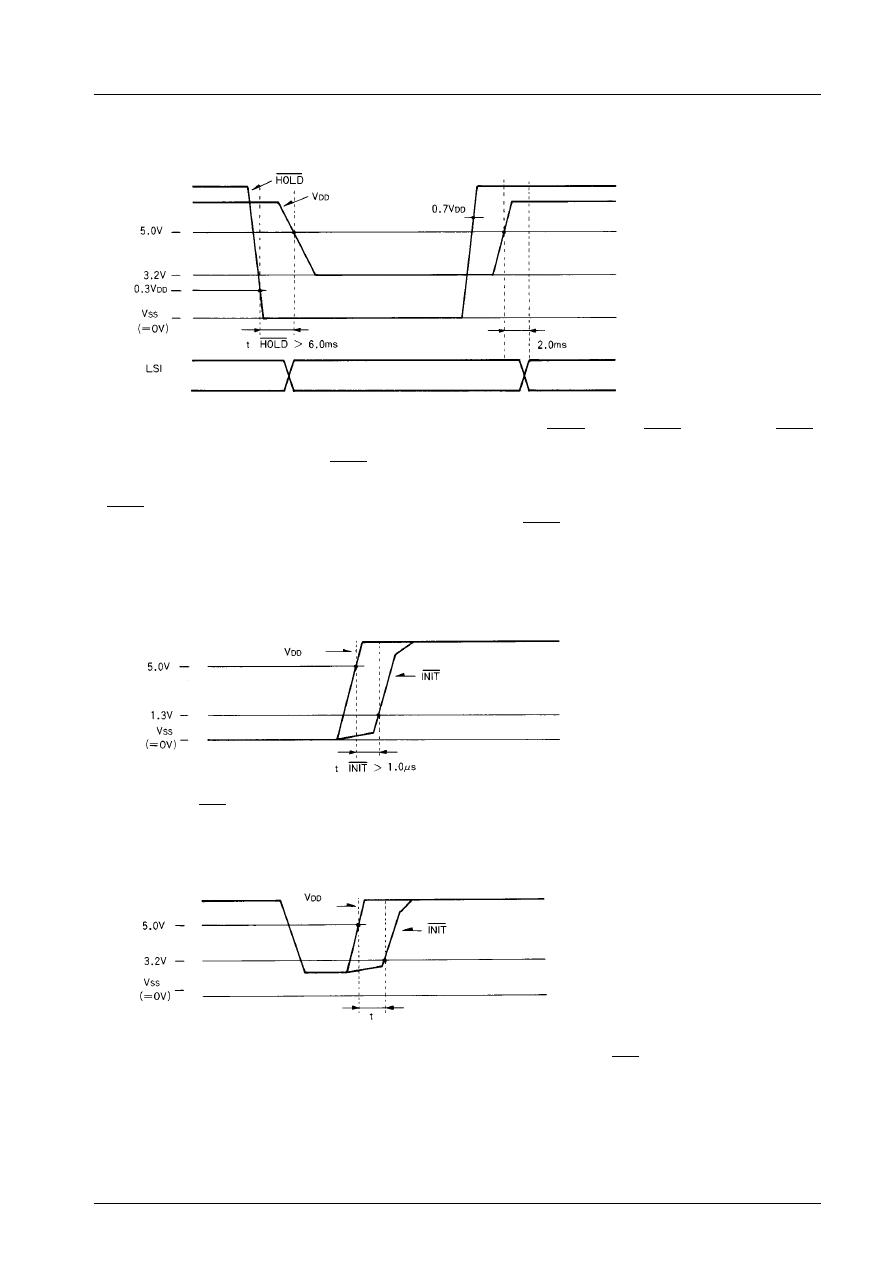
(3) Timing Requirements for Hold Mode
V
DD
must remain at 5.0 V or higher (crystal oscillator requirement) for 6.0 ms (t HOLD) after the HOLD line is asserted (HOLD
= 0 (< 0.3 V
DD
). After this, V
DD
may go as low as 3.2 V.
There are no constraints on timing for the HOLD and V
DD
pins when the chip is leaving hold mode.
The signal can be activated in one of two orders.
If HOLD is already deactivated (> 0.7 V
DD
), the LC7185-8750 leaves hold mode within 2.0 ms after V
DD
rises to >5.0 V.
If V
DD
is > 5.0 V, the LC7185-8750 enters normal mode within 2.0 ms after HOLD is deactivated.
(4) Reset Timing
1.
Reset timing (e.g. battery replacement)
Note: tINIT should be greater than 1.0 µs.
2.
Reset caused by a sudden voltage (V
DD
) drop
If V
DD
drops momentarily down to less than 3.2 V and rises up to more than 5.0 V t > tINIT (t > 1.0 µs), a reset may be
generated.
pin
pin
Normal mode
Hold mode
Normal mode
pin
pin
pin
pin
LC7185-8750
No. 3356-10/12

Frequency Table (U.S.A.: LC7185-8750)
CHANNEL
FREQUENCY
(MHz)
RX (TX = 1)
TX (TX = 0)
N
Fvco
N
Fvco
1
26.965
6508
16.27
5393
13.4825
2
26.975
6512
16.28
5395
13.4875
3
26.985
6516
16.29
5397
13.4925
4
27.005
6524
16.31
5401
13.5025
5
27.015
6528
16.32
5403
13.5075
6
27.025
6532
16.33
5405
13.5125
7
27.035
6536
16.34
5407
13.5175
8
27.055
6544
16.36
5411
13.5275
9
27.065
6548
16.37
5413
13.5325
10
27.075
6552
16.38
5415
13.5375
11
27.085
6556
16.39
5417
13.5425
12
27.105
6564
16.41
5421
13.5525
13
27.115
6568
16.42
5423
13.5575
14
27.125
6572
16.43
5425
13.5625
15
27.135
6576
16.44
5427
13.5675
16
27.155
6584
16.46
5431
13.5775
17
27.165
6588
16.47
5433
13.5825
18
27.175
6592
16.48
5435
13.5875
19
27.185
6596
16.49
5437
13.5925
20
27.205
6604
16.51
5441
13.6025
21
27.215
6608
16.52
5443
13.6075
22
27.225
6612
16.53
5445
13.6125
23
27.255
6624
16.56
5451
13.6275
24
27.235
6616
16.54
5447
13.6175
25
27.245
6620
16.55
5449
13.6225
26
27.265
6628
16.57
5453
13.6325
27
27.275
6632
16.58
5455
13.6375
28
27.285
6636
16.59
5457
13.6425
29
27.295
6640
16.60
5459
13.6475
30
27.305
6644
16.61
5461
13.6525
31
27.315
6648
16.62
5463
13.6575
32
27.325
6652
16.63
5465
13.6625
33
27.335
6656
16.64
5467
13.6675
34
27.345
6660
16.65
5469
13.6725
35
27.355
6664
16.66
5471
13.6775
36
27.365
6668
16.67
5473
13.6825
37
27.375
6672
16.68
5475
13.6875
38
27.385
6676
16.69
5477
13.6925
39
27.395
6680
16.70
5479
13.6975
40
27.405
6684
16.71
5481
13.7025
V
CO
(TX) = RF
÷
2
V
CO
(RX) = RF – 10.695 MHz (IF)
CH1: V
CO
(TX) = 26.965
÷
2 = 13.4825
V
CO
(RX) = 26.965 – 10.965 = 16.27
LC7185-8750
No. 3356-11/12
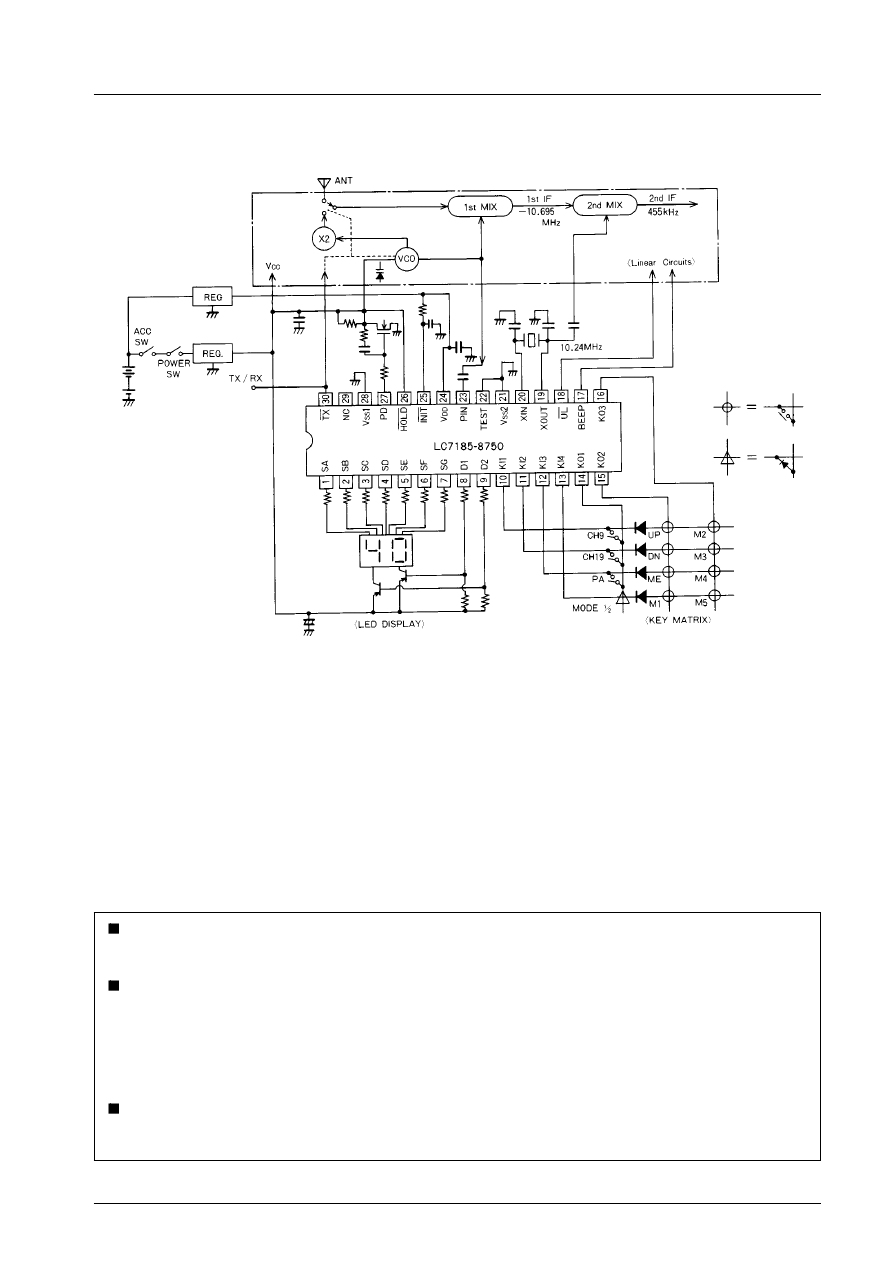
Sample Application Circuit
No products described or contained herein are intended for use in surgical implants, life-support systems,
aerospace equipment, nuclear power control systems, vehicles, disaster/crime-prevention equipment and the like,
the failure of which may directly or indirectly cause injury, death or property loss.
Anyone purchasing any products described or contained herein for an above-mentioned use shall:
1
Accept full responsibility and indemnify and defend SANYO ELECTRIC CO., LTD., its affiliates, subsidiaries and
distributors and all their officers and employees, jointly and severally, against any and all claims and litigation
and all damages, cost and expenses associated with such use:
2
Not impose any responsibility for any fault or negligence which may be cited in any such claim or litigation on
SANYO ELECTRIC CO., LTD., its affiliates, subsidiaries and distributors or any of their officers and employees
jointly or severally.
Information (including circuit diagrams and circuit parameters) herein is for example only; it is not guaranteed for
volume production. SANYO believes information herein is accurate and reliable, but no guarantees are made or
implied regarding its use or any infringements of intellectual property rights or other rights of third parties.
This catalog provides information as of July, 1998. Specifications and information herein are subject to change without notice.
LC7185-8750
PS No. 3356-12/12
Wyszukiwarka
Podobne podstrony:
LC7185 8750
8750
8750
8750
8750
1 zarządzanie nieruchomościami wprowadzenieid 8750
8750
8750
SCH 1001Z LC7185
więcej podobnych podstron